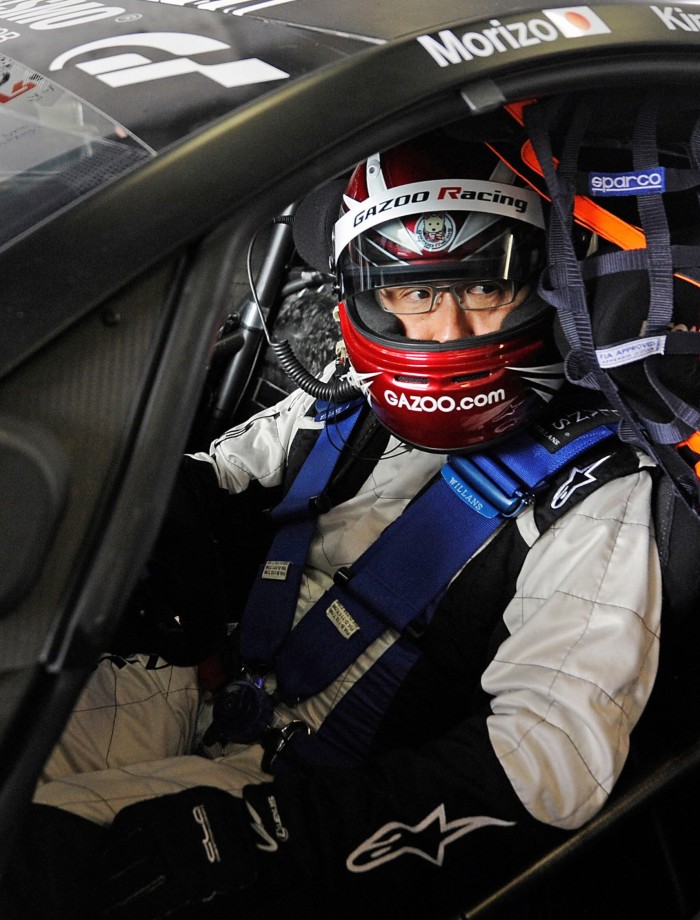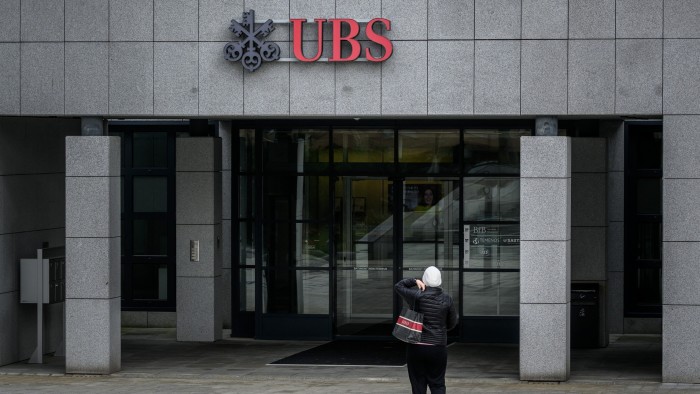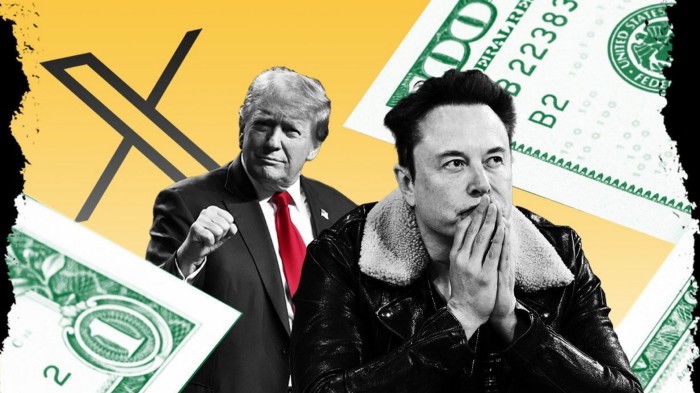Akio Toyoda takes the wheel

Morizo is holding court at the foot of Mount Fuji. The location is the edge of a 4.5km-long speedway, where he’s just brought his multicoloured GR Corolla to a standstill. This Toyota is racing using liquid-hydrogen fuel. The driver’s door opens and out steps Morizo, clad in his trademark black-and-yellow racing gear, face hidden behind a bulbous helmet.
The crowd, many of whom have come specifically to brush shoulders with this living legend, erupts in cheers. Making his way off the track, Morizo is trailed by journalists, Toyota employees and a security detail, as well as by a gaggle of “Race Queens”, dressed in matching miniskirts. He stops to hand out stickers, featuring a cartoon of himself with the phrase “I love cars”. Fans who don’t manage to get one can console themselves in the gift shop or booths, which sell Morizo pins, Morizo posters, Morizo key chains.
Morizo was not always this famous; that is not even his real name. The man behind the visor is Akio Toyoda, the 69-year-old grandson of Toyota’s founder, Kiichiro Toyoda, and the company’s most powerful executive since 2009. Several years before taking over the family business, Akio began taking racing lessons from Toyota’s “master driver”, Hiromu Naruse. Unlike his grandfather and father, he had not studied engineering and was criticised for lacking technical knowledge. Then in 2007, when Akio was still just a vice-president, Naruse convinced him to participate in the Nürburgring 24 Hours, the endurance race that takes place annually in Germany.
It was around this time that Morizo — half-mascot, half-disguise — was born. The persona was partially invented to help shield Akio from internal criticism that a key corporate executive driving racing cars might be inappropriate or too dangerous. “It’s a mask, sure,” said one Toyota insider. “But he also knows how to use it . . . to promote things he wants to promote.” One of the company’s top engineers once explained that Morizo is not “a driver that wins” but “a driver that builds”, adding: “He can speak with the cars.”
If not exactly that, in the 16 years since Akio was appointed to run Toyota, he has rescued the company multiple times, navigating massive recalls, record losses following the global financial crash and a supply-chain crisis after the 2011 Tohoku earthquake and tsunami. More recently, his scepticism about the pace of the industry’s transition to electricity has paid off, firmly cementing Toyota’s place as the world’s largest auto manufacturer by volume. The company’s annual revenues now account for roughly 8 per cent of Japan’s nominal GDP.
And yet, Akio’s reign over a vast empire of subsidiaries and suppliers, collectively responsible for more than 380,000 jobs around the world, has started to show signs of strain. This article is based on interviews with more than 20 current and former executives, employees and people acquainted with Akio. Some of his strongest supporters fear that the devoted following that surrounds him has instilled a sense of entitlement over a company in which the Toyoda family technically owns a combined stake of less than 2 per cent. They say he is surrounded by loyalists and are particularly troubled by the influence of one younger female employee.
Even Toyota’s famously reticent shareholders have begun to raise governance concerns, dissent that would have once been unimaginable. They fear that Toyota has been too slow in improving its governance, just as it comes under threat from the rise of Chinese EVs and escalating trade wars. Bizarrely, the angst about Akio’s leadership has also spilled into public view in the form of a series of fictional best-sellers that appear to have similarities with aspects of his biography.
Toyota declined to make Akio available for an interview for this article. But the company said that, under his leadership, Toyota’s share price has nearly doubled in the past five years. The company has become “an agile, quick decision-making organisation” and is in “a very robust competitive position” to tackle the car industry’s “once-in-a-century transformation”. The company added: “It is widely recognised that Akio Toyoda is one of the world’s most respected industrialists and has led Toyota through an unparalleled period of growth.”
During the Mount Fuji racing event, Akio touted his vehicle’s alternative fuel. It was classic Morizo, blending alter ego with the company’s very real strategy.
Even from early childhood, a certain solitude has defined Akio Toyoda’s life. Being born the scion of Japan’s most famous company afforded special treatment, but it also frequently isolated him. Akio long nurtured a fascination with his grandfather, Kiichiro, who died at the age of 57, a few years before he was born. It was the visionary Kiichiro who turned the family’s loom-making business into a fully fledged automaker. Though he did not live to see it, Kiichiro made it possible for the company to launch the Toyopet Crown in 1955, which became Japan’s first domestically produced passenger car and the first Japanese vehicle to be exported to the US. When Akio turned 57, he made a pilgrimage to his grandfather’s tomb and promised to usher in the world Kiichiro had imagined. “Please use me to fulfil your dreams,” Akio said, according to a video posted on Toyota’s internal website.
Akio had attended Babson College in Massachusetts for his MBA, where he was able to experience life “as a normal person” for the first time, because people did not recognise his name, according to a semibiographical book endorsed by Toyota. Afterwards, he spent a few years working at investment bank AG Becker and consulting firm Booz Allen Hamilton. According to the book, when he finally joined Toyota in 1984, Akio’s father, then the company’s president, told him that no one would want to have him as a subordinate. True to the warning, many employees chose not to engage with Akio.
Toyoda family members were major shareholders in Toyota when the company was founded in 1937. Over the years, the family’s stake in the group has shrunk, but its influence over its management and strategy hasn’t. Even when it was run by a string of high-profile “outsiders”, some of whom clashed with the family, Toyota’s direction was heavily guided by the living Toyodas. (The company’s name was taken from the founding family’s, but slightly tweaked, in part because it was considered to bring good fortune when written in Japanese.) Today, Akio personally owns a 0.18 per cent stake, worth about $550mn. He is also investing his personal money in a $33bn buyout of Toyota Industries, a key subsidiary.
Toyota said the company was “not unduly influenced by the Toyoda family”. If members of the Toyoda family choose to join the company, they are subject to the same process as any other employee, it added.
In later years, people who worked with Akio said he loosened up. He could be seen having lunch with his colleagues at the company canteen. Akio quickly rose through the ranks and joined the board at age 44, in 2000. He took over as president nine years later, just as the global recession dragged Toyota to a $4.4bn loss, its first red ink since 1950.

Then came the recall. From 2009 to 2011, more than 10 million Toyota vehicles had to be recalled worldwide due to sticky accelerator pedals and a design flaw that caused accelerators to become trapped by floor mats. The recalls led to outcries, particularly in the US, over the safety of the company’s vehicles and its compliance with regulations.
The crisis forced Akio out of his shell. Hauled in front of Congress, he admitted that, under his predecessors, Toyota had “pursued growth over the speed at which we were able to develop our people and our organisation”. Lifting his eyes up occasionally from prepared notes, Akio followed with words many employees remember to this day: “I am the grandson of the founder, and all the Toyota vehicles bear my name. For me, when the cars are damaged, it is as though I am as well.”
Walking a fine line between humility and confidence, Akio embraced his role as the symbol of Toyota and his responsibility to his family’s legacy. “My life has always been about wrestling with the question of whether I am a person needed by Toyota or not,” Akio said in an internal video, looking back on the episode years later. “But for the first time, I felt I could contribute to Toyota and that maybe this was why I had existed all along. If I could protect the company in exchange for my life, there was nothing more that would make me happier.”
In a rebuttal of previous management regimes’ focus on expansion, Akio blocked the construction of new plants for three years and pushed his engineers to build more attractive cars that he tested himself. People who have worked with him say his attention to product details and knowledge of local markets is “phenomenal”. He was also deeply drawn to the long-term management philosophy of Hiroshi Tsukakoshi, the 88-year-old former chair of Ina Food Industries and a legend in corporate Japan for leading the maker of agar, a jellylike substance made from seaweed, through 48 consecutive years of profit and revenue growth.
When Toyota returned to form and achieved its highest-ever profit and vehicle sales in the 2013 fiscal year, Akio cited his mentor’s teachings and again denounced short-termism. “What is important is that the record results are not due to luck, but rather the result of steady growth,” Akio told Tsukakoshi in a joint interview published in a Japanese magazine in early 2015. Tsukakoshi, who has advised many executives at Toyota and its subsidiaries, said Akio had succeeded in changing the mood at the company. “He knows how to take good care of people,” Tsukakoshi told the FT. “He has a love for employees.”
In the years following Toyota’s rebound, people who worked with Akio began to notice changes. Around 2016, certain people who appeared close to Akio were promoted, while several others who spoke up against him were pushed out. In a highly unusual appointment that year, Toyota brought Koji Kobayashi back. The 76-year-old, who had been sidelined to a subsidiary under a previous regime, had earned Akio’s trust by treating him like “a normal employee” when he was his supervisor earlier in the Toyota heir’s career, according to a person with knowledge of the relationship.
Then, in early 2018, Kobayashi was installed as chief financial officer, sending shockwaves across the company because he replaced Osamu Nagata, a well respected executive who had taken the position only nine months before. Nagata had played a crucial role after Akio took over as president, fixing the reporting lines that delayed communication between regional teams and headquarters in Japan, a key factor in the recall debacle. It remains unclear why Nagata was removed, but it was around that time there was a marked shift in Akio’s leadership style, said one person who worked with him. (Kobayashi, who is no longer CFO, continues to advise Akio.)
Toyota said it was not unusual for executives to go to group companies or depart and return to the carmaker. The company added that its appointments are based on the concept of “the right person for the right job” and that has contributed to its competitive position. In the case of Nagata, his skills and experience were needed at the time to strengthen its manufacturing subsidiary Toyota Motor Kyushu.
At times, however, Akio’s management decisions have appeared erratic. In 2020, for example, he abolished the title of executive vice-president, only to restore it two years later. Then in 2023, he replaced the three individuals who took over the revived EVP positions. Former employees said the frequent changes in the executive line-up led to Akio being surrounded by people who seemed unable or unwilling to question him. In a 2020 interview with Chunichi Shimbun, a local newspaper, Akio seemed to acknowledge the issue and his desire to fix it. “Even if I tell them that I will listen,” he said, “since I am older and have experience and a higher title, they would hesitate.” (The reporter who interviewed Akio at the time is now a non-executive director at Toyota, an appointment that has been questioned by the company’s proxy adviser.)

Toyota said executive appointments are based on recommendations by a panel that is majority composed of non-executive directors through “a fair, meritocratic and transparent” process. Akio does not take part in the deliberations, the company added, and he cannot make executive appointments individually. Toyota said executives who are routinely assigned to these missions are not sidelined or demoted. “It is not accurate that individuals who voice dissent are excluded or removed from such positions,” the company said.
Kenta Kon, the former chief financial officer who served as Akio’s secretary for nearly eight years, said he was pleased when he was reassigned from being executive vice-president to become the finance chief at a Toyota subsidiary, a move others saw as a demotion. “Both are important roles for me,” he said. “I was happy to take on a new challenge.”
Asked what Akio was like, Kon described his boss as “a nice person” who would not forget to greet the bus driver or the security guards every morning. “He thinks the truth lies at gemba (the factory floor). He often says Toyota places value on public interest, and that’s why the company always needs to be open,” he added. When asked if Akio had any faults, he declined to comment.
Yoichi Miyazaki, who replaced Kon as CFO in 2023, said the frequent changes and new initiatives were needed to ensure “the survival” of Toyota and Japan’s automotive industry in the face of competition from Chinese rivals: “There is no way . . . that we would appoint some people to important positions due to chumminess because we need to survive. We wouldn’t be able to explain that to our shareholders.”
People inside the carmaker say it has also become more difficult to speak directly with Akio. A person who worked on a Toyota project in Europe said that when the boss acted in an imperious manner, employees tend to follow suit. Several people said the changes helped trigger the departure of high-level employees in several important divisions, including finance, human resources and accounting. This is especially notable in a company where offering lifetime employment is still considered a virtue.
After Toyota launched an internal news website called Toyota Times in early 2019, for instance, and began using it to make major announcements instead of engaging with mainstream media, a number of longtime communications staff left. Another former executive said: “Toyota is not a normal Japanese company . . . It is a public institution. It needs to be humble.” The company said Toyota Times was “a perfectly normal communications tool” and attributed the departures to the pandemic.
Among the various staffing moves that have caused insiders to worry about the company’s governance, none has stood out more than those of one Toyota employee in her early thirties. Ayumi (her name has been changed for this article) started out as a member of the event staff team at motor shows held at the Suzuka circuit and other fixtures in Nagoya, near Toyota headquarters. She met Akio about a decade ago, while she was serving at parties held at a high-end restaurant frequented by Toyota executives as well as its sales managers and clients.
Within a few years, Ayumi became a full-time Toyota employee and was appointed to the position of Akio’s “manager”. It was an unusual title, with a role akin to his personal secretary. Five people told the FT that Akio and Ayumi were frequently seen working together. Between 2018 and 2019, Ayumi accompanied Akio on several business trips, including to attend dealer meetings in the US, flying with him on Toyota’s corporate jet, according to two people with direct knowledge of the matter. In 2021, Ayumi attended Akio’s son’s wedding, as one of his secretaries, surprising some of the attendees.
According to multiple employees, there was concern Ayumi had accumulated influence in the company. As one of the most prestigious companies in Japan, which attracts talent from the country’s top universities, it is highly unusual for a person with her background to become a full-time employee at Toyota mid-career, even more so in a crucial position supporting the chair.
Toyota strongly rejected the notion there was anything unusual about Ayumi’s employment. She worked at the chair’s office and was responsible for schedule and logistical matters, it said. “Therefore, it is entirely normal that she would accompany Akio Toyoda on overseas trips together with other members of the team.”
She was not, Toyota added, in a management position. “There are many employees within Toyota Motor who bring diverse backgrounds to their roles, and this is something we celebrate as an organisation.” His son’s wedding, it noted, was attended by around 1,000 people, including other members of Akio’s support team. “There is nothing unusual or surprising about her attendance.” Toyota said that Ayumi has since been reassigned internally “in the ordinary course of business”.
The first book in the Ambitions of Toyotomi trilogy was published in Japan in 2016. The novel and its two sequels follow the fortunes of a fictional industrial family with an uncanny resemblance to the Toyodas. The series, released by two of Japan’s biggest publishers, became an instant best-seller among business titles, with a total of 280,000 copies sold.
One episode in the series takes place in the spring of 2018. Nine years after taking the helm of Japan’s biggest carmaker, Toichi Toyotomi goes on a rare road trip with his ageing father, Shintaro, to the family’s lakeside villa in Shizuoka prefecture. Toyotomi Motor built its name on the success of Prometheus, a hybrid vehicle that launched in the late 1990s. But since then, the company has struggled to seize the lead in the industry’s transition to electric vehicles.
As Toichi’s leadership comes under greater scrutiny, his relationship with his father grows increasingly strained, even though they live on the same compound near the company’s headquarters. “Do you want to call it quits?” Toichi’s father asks, clearly anxious about the company’s future. “People are already critical of family-run businesses, and they will only worship you when you’re delivering. As soon as you stop delivering, people will blame the poor performance on the founding family’s management.” Humiliated by his father’s doubts, Toichi responds that it is too soon to give up.
The exchange is fictional. Even so, some Japanese readers heard echoes of Akio’s relationship with his father, who passed away in 2023. The two men also lived on the same compound for a long period, often eating breakfast together, as Akio sought advice from his father about the company’s strategy and management. The novel’s Prometheus is similar to Toyota’s Prius. And, at one point, Toichi meets a woman, serving at company events, eventually making her his personal secretary. The two characters are described as frequently travelling together; she also attends his son’s wedding.
Writing under the pen name Saburo Kajiyama, the author is unsparing in his criticism of the outsized control the fictional founding family wields over the imaginary automotive company. The identity of the real writer or writers remains a mystery and fodder for gossip among Toyota board members. People with knowledge of the series’ publication told the FT that the books were written by former top automotive reporters.
Longtime Toyota watchers say the fact that Akio, however fictionalised, has become a topic of public discussion is a rarity in a country where the company’s influence is so widespread that critical articles can immediately lead to cancellations of lucrative newspaper and TV advertisements, as well as journalists being barred from events. “Toyota has long led the Japanese economy and there is a unique situation where no one can say anything negative about the company,” said Shinji Hatta, professor emeritus at Aoyama Gakuin University. He added that the novels were a particular exception. “Since he’s always been protected by his close aides, chairman Akio is in some ways an emperor without clothes.”
Toyota responded by saying it values “constructive criticism that helps ‘produce happiness for all’ as per our mission”.
Even though the Ambitions of Toyotomi is fiction, Toyota felt the need to react when the final instalment of the series came out in late 2023. Koji Sato, the chief executive who took over when Akio became chair, wrote a letter to employees seen by the FT, in which he criticised the books’ content as defamatory. “Akio Toyoda . . . is absolutely not the kind of person who will flaunt the fact that he is a member of the founding family,” Sato wrote. “It is each one of us who works at Toyota who knows the real Toyota.”
Toyota said the memo was sent “to avoid confusion among employees”.




Then last June, just days ahead of the company’s annual shareholders’ meeting, another work of fiction entered the picture. This time, it was the publication of a sci-fi novel, Toyota’s Child. The book, authored by Eri Yoshikawa, primarily a mystery writer, and partially based on interviews with Akio, opens with a young Akio Toyoda attending a memorial ceremony for his great-grandfather. During the service, he tumbles back in time, meeting his grandfather, as he is struggling to turn the loom business into an automaker.
Akio eventually revisits other key turning points in the company’s history, based on real-life events, such as his 2009 ascension to the presidency. In the book, he is depicted as being seen by others around him as spoiled and undeserving of his position — until he overcomes the recall crisis.
Toyota’s Child, which is promoted on the company’s internal website, contains a number of striking revelations about the semifictional Akio’s motivations. At one point, he wishes “to go to a world where it’s filled with people who do not know the company Toyota Motor”. Ultimately, the story paints Akio as a transformative figure on the same level as his grandfather. The real-world Akio seemed to approve, commenting on social media: “Twice this book brought me to tears . . . Through this novel, the dream of meeting my grandfather finally came true.”
Nothing speaks to Akio’s ambition to transform the company as radically as his grandfather did than Woven by Toyota, Inc. Formerly a research division with planet-wide ambitions, the subsidiary was renamed and relaunched in 2023. It is responsible for creating future generations of Toyota’s vehicle operating system, automated driving and safety software, and operates an $800mn investment fund. A 2021 filing revealed that Akio had invested ¥5bn of his own money in the group, a highly unusual move intended to convey how important he considered the division to Toyota’s future.
Woven is also responsible for developing the “company town” Toyota is building at the base of Mount Fuji. Akio announced the “prototype city of the future” at the Consumer Electronics Show in 2020, saying it would test autonomous vehicles, smart home technology and robotics with a population of real people living there full-time. Renderings of the site show clusters of futuristic, glass-and-concrete high-rises, intersected with pleasant greenways. Beyond promises of “a city that is full of happiness”, Woven embodied Akio’s vision of shifting Toyota from manufacturing vehicles to providing infrastructure and mobility services. He has said that is the key to adapting to an era when making cars alone will no longer generate the high profits of the past.
A dynastic tradition appears set to continue at Woven, where Akio’s son, Daisuke, was installed in the key position of senior vice-president in 2018. He is also in charge of the smart city. Although Daisuke is only 37 years old, many people inside the organisation assume that he will someday take over as chief executive.
Before joining the company, he followed an identical path to his father’s, graduating from the same university in Japan and obtaining an MBA at Babson. Like Akio, Daisuke is also an avid racer. (Unlike Morizo, he drives under his own name.) People who have worked with Daisuke describe him as “down to earth” and “a nice guy”. But “in order for Daisuke to reach the helm of Toyota and govern it, he needs to demonstrate success,” said Takaki Nakanishi, a veteran automotive analyst. Daisuke’s success, he added, will be a prerequisite for the family to maintain its exceptional hold on the company.
Toyota said Daisuke’s current position does not indicate he is being prepared to take over as CEO. It added that leadership succession will be deliberated on by its executive-appointment panel, on the principle of “right person for the right job”. Kon, who is now Woven’s CFO, described Daisuke as “a wonderful leader” and added that few people inside the company viewed him as a future chief executive.
Woven’s progress has, so far, been uneven. Several people close to the division said Toyota had to “reset” the business in 2023, replacing former Google executive James Kuffner as its chief with an executive from its supplier Denso. Kuffner had been hired to bring Silicon Valley-style management to Toyota’s bureaucracy. (At the time, Daisuke reported to him.) “Some differences in opinion were linked simply to management style rooted in cultural differences between how things are done in the US, in Silicon Valley, and in Japan,” Kuffner told the FT, “which were difficult to overcome. But Akio supported me throughout, and I am very grateful for that.”
Since the reset, some of Woven’s loftier ambitions have come down to earth. Plans to create “a happier planet” were curtailed in favour of developing new vehicle software that analysts, including Nakanishi, say is “far from cutting-edge”. But it is more practical, allowing dealers to improve the quality of vehicles even after they have been sold, for example. Relatively little is known about the work Daisuke is overseeing at the smart city. Public filings show that the unit has generated losses for three of the past four years with liabilities exceeding its assets by ¥25.8bn ($180mn) for the fiscal year that ended in March 2024. The loss is still tiny compared with Toyota’s overall revenue of $330bn and operating profits of $33bn.
Later this year, if all goes according to plan, people will be able to see what Woven has been working on when the smart city is opened to about 100 residents to test Toyota’s self-driving vehicle, drones and robots. The software, called Arene, was also recently unveiled for deployment in the new Rav4 sport utility vehicle to enhance its safety features. How these are received could determine whether Woven is ultimately seen as a business that could fundamentally alter the company’s strategic direction or more as a powerful chair’s pet project. “I’m not sure if it is cutting edge, but . . . the software platform is very good . . . and it is steadily bringing Toyota closer to an SUV we are aiming to develop,” Kon said.
As chair, Akio continues to control key aspects of the company, including product-review sessions in his role as master driver. Remarks he has made to employees suggest he believes he is still best-fit to run the company. “If you get that much right for so long, in a company that carries your name,” said one long-serving senior executive, “it’s only natural you start to think you can get nothing wrong.”
In recent years, a number of subsidiaries have been hit by a series of testing and emissions-data scandals, undermining Akio’s longtime mantra to build “ever-better cars”. The issues have extended beyond Japan, with its truck subsidiary Hino Motors being fined $1.6bn in the US for emissions fraud, involving 105,000 diesel engines between 2010 and 2022. The company’s 10-member board also includes three non-executive directors with past or existing business interests with Toyota, who have been categorised as not fully independent by proxy adviser ISS. Akio’s approval rating among shareholders has fallen from 96 per cent to 72 per cent in the past two years of Toyota’s annual meeting, a figure that would have been unthinkable in the past, considering that a large portion of its shareholder base is made up of domestic financial institutions and subsidiaries unlikely to challenge management.

In February this year, Toyota seemed to acknowledge there was room for governance improvement by proposing a suite of changes to its board that would increase the number of independent directors to make up half of its seats. It will also create a new audit and supervisory committee that will be composed mainly of non-executive directors. “There is no evidence that corporate governance is not functioning effectively,” the company said, adding that its outside directors meet the independent criteria set by stock exchanges. Shareholders will vote on the proposed changes at the upcoming annual meeting this month. As they do every year, they will also be polled for their approval rating of Toyota’s chair, which is expected to rise.
Christopher Reynolds, who will join the board pending shareholder approval, said the company’s strong financial performance was evidence that its governance was working effectively. He added that comparing it with European and US standards might not be appropriate. “To assume that . . . Japan must align itself with western notions, I think that’s frankly arrogant,” said Reynolds. “We’re the company of kaizen, continuous improvement. As we reach for the future . . . the leadership team has set out for us, we’re going to have to change and evolve.”
Miyazaki, the CFO, said the new system allows all members of the board including auditors to take part in discussions for Toyota’s future as “one team”. “One single hero does not work for the automotive industry,” he said. “Everyone is a leader. We feel that we all need to work hard to maintain this current position.”
For Akio, though, there may only be one person whose estimation really matters. On his final day as chief executive in March 2023, Akio took a reporter for the Toyota Times to his childhood home in Nagoya. A portrait hung on the wall. “This is the only person I want to receive a compliment from,” Akio said, his voice quivering. “That he is glad that he had a grandson like me.”
Kana Inagaki is the FT’s industry editor.
David Keohane is the FT’s Tokyo correspondent
Find out about our latest stories first — follow FT Weekend Magazine on X and FT Weekend on Instagram





